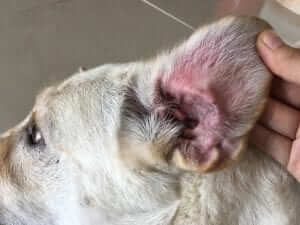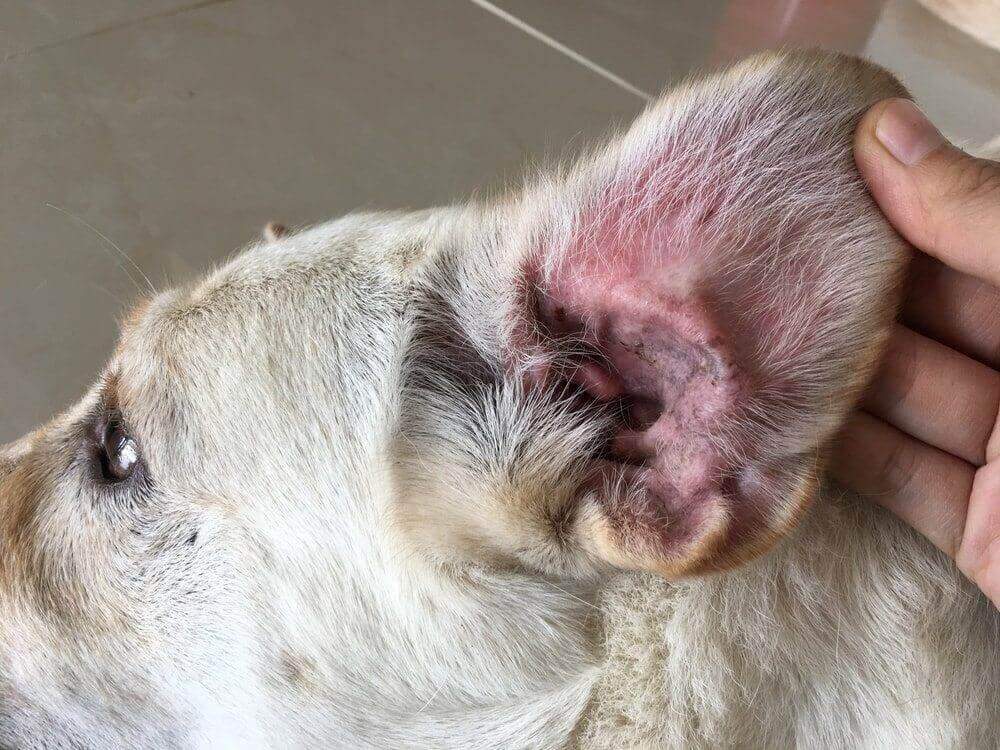Veterinarians will often refer to many allergy conditions as ‘ears and rears’ in dogs or pets. In many cases, the problems came in two’s. This implies the pets have problems with both ears and the rear end. While in other instances, we have a problem in just one of the two areas. Ear, anal gland and allergy problems are very common in companion animal veterinary practice. They each have their own distinct underlying causes and frustrations. There is no remedy or ‘cure all’ that will totally eliminate these complaints. However, we can implement changes and dietary or supplement regimens to produce easier management.
Ear infections, anal gland and allergy problems are very common if you own a pet. How often they occur from one breed to the next. Their occurrence can also vary from once in a lifetime to happening on a monthly basis. This may require ongoing treatment on your end at home and countless visits to the veterinarian’s office. The problems can be very frustrating not only for both owner and pet, but also your veterinarian. The reason for the frustration is that many times, the problem persists despite efforts to alter the course.
Ear Infections In Dogs:
The ears are vital for our pets to hear, listen for danger and react to their environment. However, in many pets, infections seems to be a part of their daily lives. Ears infections are common and generally are due to either bacterial or fungal (yeast) causes. They can be minor in some or more severe in other pets. This may lead to ongoing issues and hearing loss not to mention chronic pain and discomfort.
The clinical signs most commonly seen for ear infections include:
- Crying, whining and more constant scratching at ears or rubbing head on the floor
- Odor and discharge from the affected ear
- Obvious redness, pain and swelling associated with the ear
- Reluctance to let you pet head or handle the ear
- Head tilt to one side or loss of balance
- Generalized body scratching due to allergy conditions
Diagnosis is based on:
- Veterinarian clinical examination (otic exam)
- Culture and cytology of debris or discharge
- Skull radiographs (x-rays) if chronic
- Bloodwork
Most ear infections are actually bacterial in nature, with a wide range of different types of bacteria that may be present and implicated. Ear infections can be primary or secondary in nature as well. This means they can occur on their own after a swim in a pond or secondary due to an ongoing allergy. In many of those cases, we will also have a yeast or fungal component (Malassezia) which are secondary in most situations, with the yeast being an opportunistic organism that takes advantage of a compromised environment including pH changes. Culture and cytology will help determine bacterial or fungal infections. Certainly not uncommon to have both but in more chronic cases, it is also not uncommon to see more yeast than bacteria.
Each breed is different with some more predisposed to others for various reasons. The most common breeds impacted by ear problems include Labradors, German Shepherds, Bassett Hounds, Beagles and many other breeds that have floppy ears that lie next to the head. Any breed that likes to swim is also at higher risk. The reason for the floppy ear problems is that due to ear position, air circulation is compromised, leading to retention of moisture and build up of heat, which then breeds infections. The same is true for those that like to dip in the pond or family pool often. More moisture equates to higher risk of infection. Smaller breeds are not excluded but Poodles and more ‘hairy’ smaller breeds are at higher risk not so much due to ear positiion but more so because of hair buildup in the ear canal, which can impair air movement, resulting in higher moisture and wax accumulation, then a higher risk of infection.
Management Options For Allergy and Ear Conditions in Pets:
Ear infections can be an ongoing problem for many pets, especially if associated with an allergy. Some dog owners may only have one infection in their pet’s entire life, easily resolved with appropriate therapy. More often than not, this is not the case. Here are few things to keep in mind that I have found useful in our past patients.
In all cases, the ear is cleaned and dried using specialized topical therapies while at the veterinary office. Most pets will allow for cleaning, but other pets either due to personality or perceived pain, may require sedation or even anesthesia to get the job done properly. If hair is a problem, it is plucked and removed in order to ensure proper airflow and application of medications. Usually cytology and cultures are done at this time.
First line therapy using appropriate antibiotics and antifungals is needed in almost every case, but become more questionable in the more ongoing or chronic situations. In most cases, we will prescribe either a topical medication to be applied into the ear daily or an oral antibiotic. In many, we will prescribe or utilize both options, dependent on the severity. Pain is managed through the combination of a topical steroid which is included with the antibiotics utilized in the ear. A high percentage of patients will respond with this first line therapy, but many of them will relapse due to various reasons, necessitating continued care.
If swimming is an issue for your pet, then in many of our patients, I would recommend using a small amount of rubbing alcohol applied into ear ear post swimming to help evaporate the water. In those pets with excessive ear wax production, weekly cleaning using various products can assist in keeping that debris to a minimum. I am not in favor of excessive or daily cleaning, as this can lead to breakdown of natural host defenses and even irritate the ear canal, creating more harm than good.
To me, as a veterinarian, chronic ear infections usually signal underlying gastrointestinal and immune dysfunction.
Diet is a main contributor to many pets, contributing to the excessive wax production in the ears. I have further made a connection between the existence of underlying gut health problems along side of improper diets. In those pets with ongoing ear problems, I tend to favor home cooked meals consisting of non-heating protein sources such as chicken or fish, mixed with vegetables and a rice source for carbohydrates. The red meats, in my experience, tend to increase heat and inflamamtion in the body, which can then contribute to more problems. I also feel that many commercial foods, although convenient, can contribute to gastrointestinal inflammatory issues and likewise ear and skin concerns due to added preservatives, dyes and additives, not to mention the processed nutrients present.
As a final measure in most of our chronic ear cases, after making the recommendations mentioned above, we will implement herbal therapy to assist with easier management. I firmly believe that the ‘gut’ is one of the underlying contributors to ear and skin issues,including allergies, thus try to improve the outcome through the use of home cooked diets and herbs. A combination approach of diet and herbs provides the best long-term success. Our goal is to reduce or manage inflammation in that patient, but also support GI and immune health. Herbs that I have found most useful include Curcumin (Turmeric), Boswellia, Dandelion, Parsley, Marshmallow and nutrient rich herbs including alfalfa and spirulina, which support overall cellular health. One formula that we most commonly used to help manage these patients on a long term basis is the Cur-OST SA Total Support.
One thing to keep in mind with ear problems, especially those that are ongoing or chronic, is that many are linked back to allergies which can be environmental or food based. This is not uncommon and a high percentage of these ear patients also have ongoing skin conditions. The immune response is connected back to gut health. If the GI tract is not properly working, allergies can develop due to a dysfunctional immune response. The gut is often the main underlying problem, but you have to manage contributors to the situation which include diet, hair accumulation and even stress. Ongoing ear infections are a sign, a sign of imbalance in the body. We often cannot completely cure these conditions, due to amount of damage done internally on a cellular level over time, but with some effort and the right approach, many can be managed much easier producing a happier and healthier pet.
Rear End Issues and Anal Gland Problems in Dogs:
Anal gland problems are extremely common, especially in smaller breeds. Larger breeds are not exempt, but just not as common in my experience. The anal glands are kind of viewed like the appendix in people, an organ with no perceived function. If we look at the rectum, which most do not choose to do, there is one gland on either side underneath the skin and muscle tissue, located at the 3 o’clock and 9 o’clock position, roughly. It is normal for a oily fluid with a foul odor to accumulate in the glands. Pressure with bowel movements excretes the fluid. If the glands do not express, they can increase in size tremendously, becoming the size of a quarter in some pets leading to discomfort for obvious reasons.
Signs of a problem:
- Scooting or rubbing the rear end on the floor
- Excessive licking at the rectal area
- Bloody discharge noted with bowel movement
- Foul residual ordor after sitting down on floor, bed or sofa
- Straining to have a bowel movement
Causes of anal gland fluid build up:
- Inappropriate diet leading to constipation or too soft of feces to cause gland to express
- Diarrhea or generalized loose feces
- Dietary indiscretion contributing to excessive fluid production
- Gastrointestinal or digestive concerns
- Neurological disease/muscular disease
- Dietary allergy to food ingredient
The anal glands normally produce a fluid that is somewhat the consistency of baby oil, but in many pets, that fluid becomes more dense, thicker and thus becomes harder to express on a daily basis with bowel movements. Inappropriate diet, allergy conditions, and underlying digestive concerns in dogs are often the cause of the excessive thickness to the fluid found in anal glands.
Management Options for Anal Gland Problems in Dogs:
Your veterinarian or his staff can often easily express most anal glands and relieve impactions. Many groomers will automatically express or at least check the anal glands with each hair cut appointment, but some opt not to participate in this for obvious reasons. It is not uncommon to have an owner bring in a small breed dog monthly for anal gland expression. It is something that I have tried to teach many owners, to avoid ongoing appointments, but most opt to leave it to the professionals. Expressing anal glands will provide relief when they build up fluid. Many pets will allow this and strangely become accustomed to it, but in more chronic cases, the situation can be quite painful or the fluid is just too thick to express manually. Sometimes veterinarians will give sedation or anesthesia, express the glands, and flush with a medication to help alleviate pain and infection. Some chronic cases can develop anal gland infections, which can become quite severe in some situations, not only requiring antibiotics but sometimes surgery.
As in the case of ear infections, I like to approach many of these cases from a diet and herbal point of view. I have found that by moving many of these pets away from commercial, processed foods and onto a home cooked diet, they do quite well. Just the change in diet by itself can lead to significant changes in fluid production, fluid consistency and even alleviate any underlying gastrointestinal or digestive issues which may be present. In those pets that need an extra boost towards management or have more chronic issues present, I will incorporate herbs into the program, using the same approach as outlined for ear concerns mentioned above.
If you own a dog, you have probably had your veterinarian look at them for ear, anal gland or allergy problems. Some situations are easily remedied with the right therapy, but others can create ongoing pain and suffering for both owner and pet. It is by far much easier to try to change our routines to impact management earlier in the course of the condition than it is to try to intervene later. The longer we wait, not only the more suffering, but also the more damage that occurs on a tissue level, which may impact overall quality of life and health for that pet. Through some simple changes to diet and implementation of herbal therapy, many of these situations are much easier to manage, occurring less frequently, which then equates to a happier pet and owner!
Author: Tom Schell, D.V.M., CVCH



What do you mean by non heat protein source? Do you mean raw fish/chicken or cooked chicken/beef and given to them cold?
I am more than happy to make my dogs meals every week because we are on month 4 of ear infections (both ears) and well as aggressively licking the rear end. He is not happy and hurting – since he is the best German Shepherd on the planet I need him to be happy and healthy. Please help me with more clarification… I’m desperate.
Thank you,
Danielle
Ps. What’s your stance on coconut oil ingested?
I would think it means a source of protein that does not create heat inside the body. Depending on your pet it maybe chicken or fish. I know my dog was allergic to beef (tested positive for allergy testing) and we switched her to a chicken and rice diet and that did not create inflammation/heat in her GI tract. I could be wrong.
Great article! Thanks for the insights.